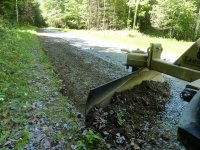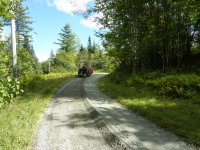Ed of all trades
Elite Member
I have had problems getting a back blade to cut into the ground if there is any veg. matter growing there.


BX and box blade made this sidehill road, about 200 feet long.
Bruce
This is how I've done it:
Use the back blade. Angle it, with the leading edge on the high hill side and lowered so the cutting edge is level not parallel to the hill. You can experiment with the top link length until the blade cuts aggressively on it's own. Drive in very low gear so you can raise/lower the blade as needed. That will pull the high soil to the low side. First pass is crude. Each pass cleans and refines the trail. That's worked great for me. Soil condition will be the determining factor though.